Coronavirus (COVID-19) support study experiences of and compliance with self-isolation: main report
This research explores compliance with and experiences of the 10 day period of self-isolation undertaken by index cases, contact cases, and international travellers during the COVID-19 pandemic. The research took place between March and June 2021.
This document is part of a collection
3. Compliance with requirement to self-isolate
3.1 Background
The important contibution of self-isolation[24] to the suppression and reduced transmission of the COVID-19 virus in Scotland necessitates an understanding of compliance. Within this is a recognition that for the self-isolation approach to be successful, those asked to self-isolate need not only to be willing to do so as advised but also able to do so within the context of their own personal circumstances. Willingness to adhere to the guidelines and a belief in the validity of the self-isolation approach have a part to play but it is recognised that there are other factors and challenges that may make it difficult to adhere to self-isolation, no matter how much an individual intends or indeed may believe that they are complying (see Chapters on knowledge and support for more on other factors that may relate to compliance with the requirement).
Throughout the fieldwork period, all those asked to self-isolate were asked to do so for 10 days, to avoid contact with others outside their household and to stay within their own home and garden (or hotel accommodation). The focus for the study with regards to compliance was to examine overall levels (both self-assessed and based on behaviours), how this may vary between case types and other demographic groups and to examine the individual components of compliance that may be proving harder for individuals to adhere to.
3.2 Compliance with self-isolation among Index and Contact Case participants[25]
3.2.1 Perceived compliance with self-isolation
When asked directly, in the survey, how well they thought they managed to comply with self-isolation, it is clear that the vast majority of Index and Contact Case participants assessed their ability to comply very positively. More than nine in ten (94%) reported that they managed to comply with self-isolation 'all of the time'. Five percent felt they complied 'some of the time' and no-one reported not managing to self-isolate at all. Index Cases were more likely than Contacts to report complying 'all of the time' (97% compared with 93%).
Here, the opt-in nature of the survey, in combination with a degree of social desirability among those that did take part, may help explain, in part, why self-assessed non-compliance was so low among survey participants. [Figure 3.1, Table 3.1]
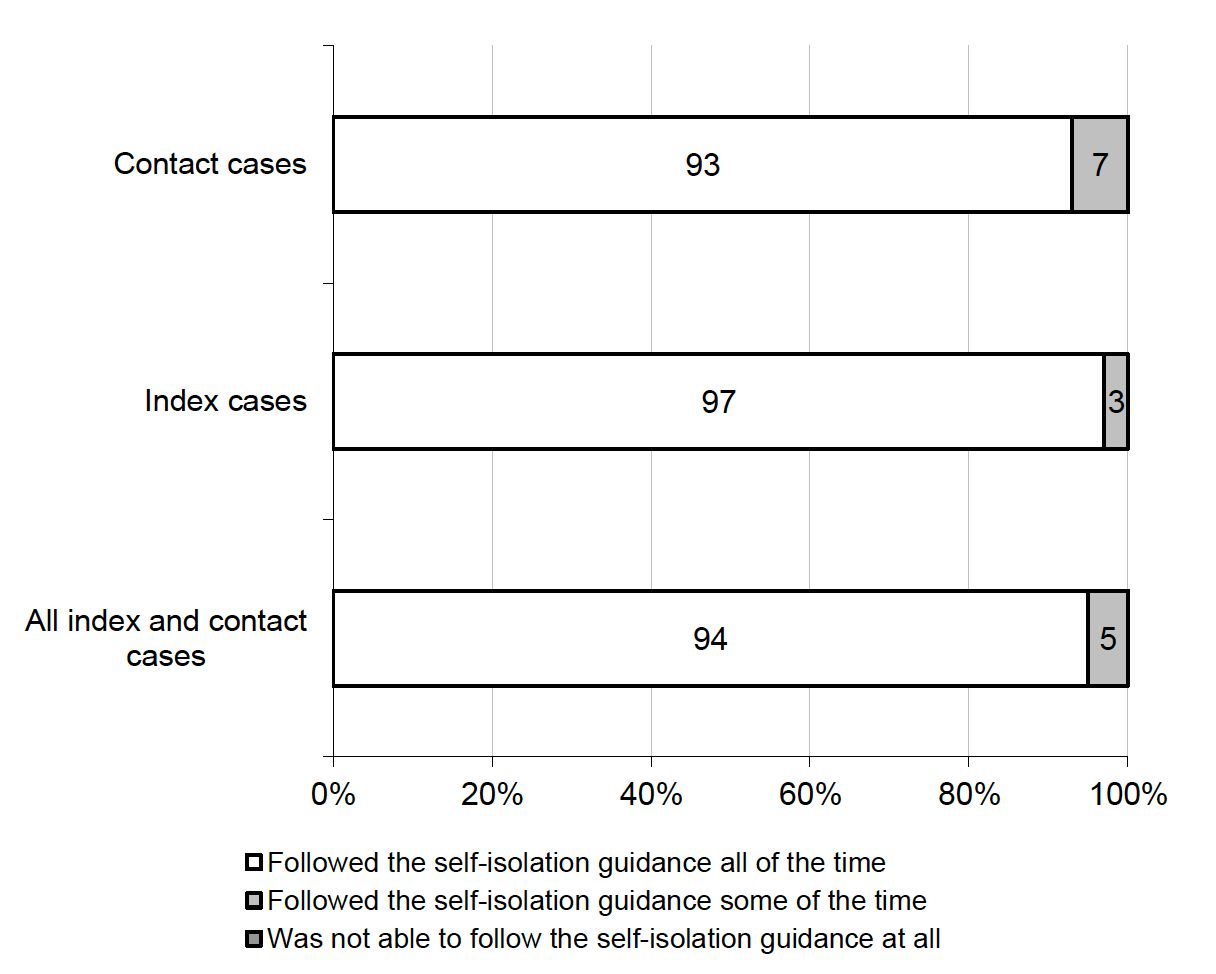
The qualitative research provided additional insights into how Index and Contact Cases viewed their own self-isolation and why self-assessed levels of non-compliance were so low. The consensus among interviewees was that the importance of the purpose of self-isolation, in protecting the wider population, meant that there was little or no temptation to flout the rules. The majority of interviewees were adamant that they had not even come close to breaching the self-isolation measures, and even those who said that they, on occasion wanted to leave the house, admitted that there was little hardship in having to isolate for such a comparatively short time period. The few exceptions to this are outlined later in this chapter. A few comments suggested that a minority were also concerned that they would be identified by others if they breached the regulations, though this did not seem to be a particularly prevalent concern.
"I and my partner have been brought up to be law abiding, to do what's best for everyone else, not what's best for ourselves…and we've been brought up old school… we were brought up in a different timescale and a different mindset, so yes, we obey the rules." (International Traveller)
"I would never forgive myself if I put somebody else in danger, so no. It was hard, but it was something you just have to do anyway…I think it's more because the job I'm in, do you know what I mean? We care for elderly, and I think, that's my motivation is the fact that I know the job I'm in and I would be absolutely appalled if somebody had to go out." (Index Case)
3.2.2 Behavioural compliance with self-isolation
In addition to asking survey participants to directly assess how well they think they managed to self-isolate, the survey tried to capture a more objective measure of compliance by asking a series of detailed questions which would both measure adherence to specific aspects of the self-isolation requirement and provide a summary measure of compliance.[26] This summary measure is referred to as 'behavioural compliance' throughout this report.
On the behavioural measure, three-quarters (74%) of Index and Contact Case participants were classified as fully complying with self-isolation at the point of taking part in the survey.[27] A quarter (25%) partially adhered to the requirement but were not able to comply with it fully and just 1% were not compliant at all – that is they either did not try to self-isolate at all or tried, but did not manage to start immediately, stay at home/accommodation for the duration or isolate for the required period of time. [Table 3.2] High levels of compliance have also been observed elsewhere in the UK, with 79% of Index Case participants[28] and 87% of Contact Case participants[29] in Engand reporting that they were fully compliant.[30] And 78% of Contact Cases in Wales[31], reporting that they adhered to the requirement not to leave their house during self-isolation.[32]
Full compliance with the requirement to self-isolate significantly declined over the survey fieldwork period[33] dropping from 79% in wave 1 to 73% then 71% in waves 2 and 3 respectively. The decline in full compliance was observed among both Index and Contact Case participants and was matched with a significant increase in partial compliance over this same period. [Figure 3.2, Table 3.2]
| Case type | Wave 1 | Wave 2 | Wave 3 |
|---|---|---|---|
| Index Case participants | 80% | 72% | 74% |
| Contact Case participants | 78% | 74% | 69% |
| All Index and Contact Case participants | 79% | 73% | 71% |
While Index Case participants were more likely than Contacts to self-assess their compliance positively, no such difference existed on behavioural compliance, with 76% of Index Case participants and 73% of Contacts assessed as fully compliant. Among Contact Case participants, those who lived with someone who tested positive were more likely than those in close contact with someone outside their household who tested postive, to fully comply with the aspects of self-isolation captured in the summary measure (78% and 70%, respectively). [Table 3.2]
Behavioural compliance was not uniform across different groups of participants. Woman (76%) were significantly more likely than men (71%) to fully comply with self-isolation. Similarly, full compliance was significantly higher among those aged 65 and over than among the youngest age group (80%, compared with 68% for those aged 16-24). [Table 3.2]
Interestingly, those that accepted the offer of Local Authority support during self-isolation were significantly more likely than those who were offered, but declined, the support to fully comply with the requirement to self-isolate (84%, compared with 79%). [Figure 3.3, Table 3.3]
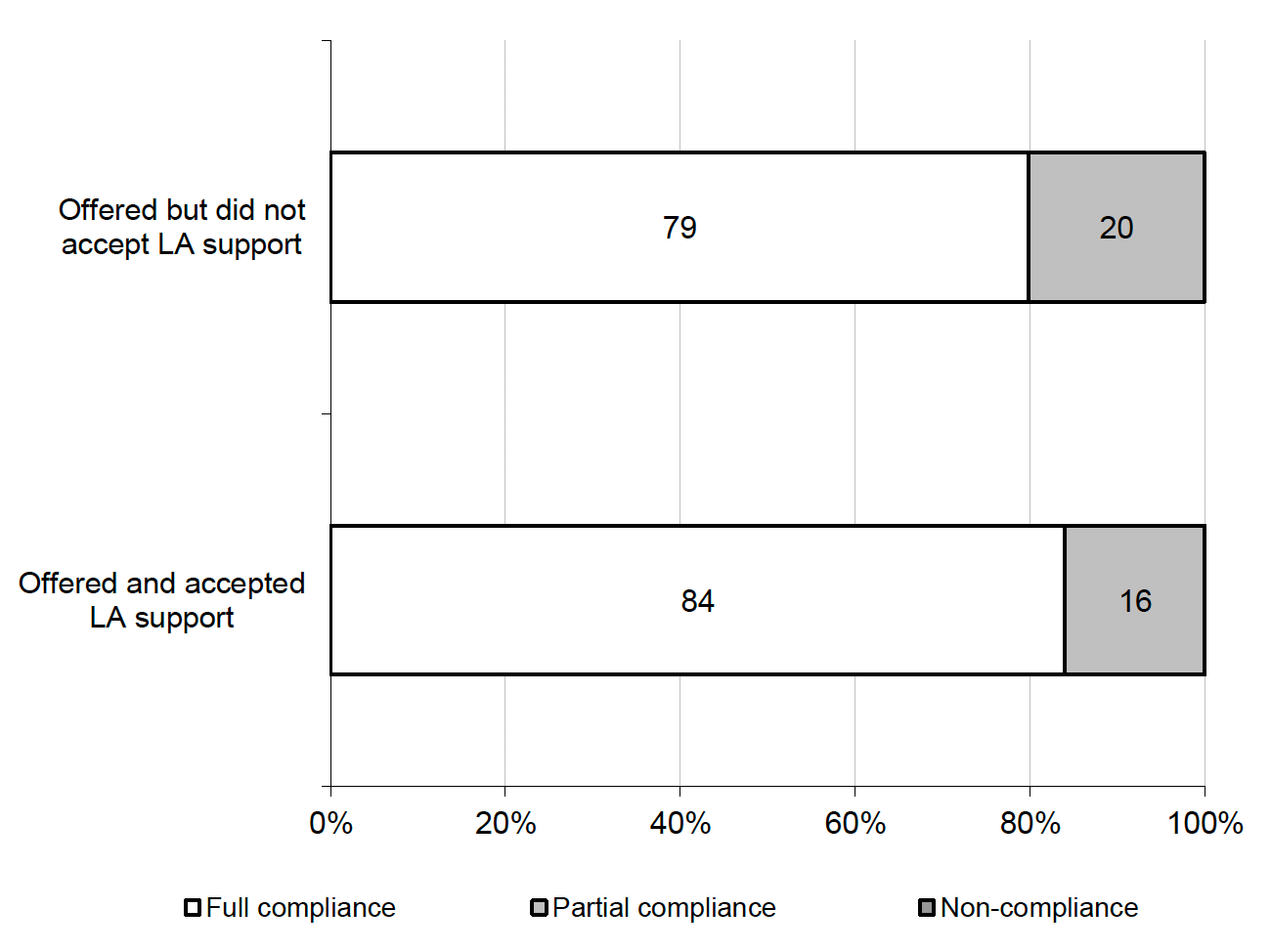
To assess knowledge of self-isolation requirements, survey participants were asked how many days a person who tested positive for COVID-19 was required to self-isolate for. Full compliance was higher among those aware of the 10 day isolation requirement than those who were not (79% compared with 62% of those underestimating the number of days and 70% of those overestimating). [Table 3.4] Views on the effectiveness of self-isolation as a strategy against the spread of COVID-19 was also associated with behavioural compliance. Those in agreement that it is an effective strategy were significantly more likely to fully comply with their own self-isolation (78% among those that agreed strongly/agreed, compared with 69% among those that neither agreed nor disagreed, disagreed strongly or disagreed). [Table 3.3]
3.2.3 Comparison of self-assessed compliance and behavioural compliance
The mis-match between participants' direct self-assessment of how well they managed to self-isolate and the survey's measure of behavioural compliance is highlighted in Figure 3.3. While the vast majority (94%) of the survey participants reported following self-isolation 'all of the time,' full-compliance stood twenty percentage points lower (74%) on the behavioural measure. Similarly, 5% felt that they adhered most of the time, partial compliance on the behavioural measure was 25%. [Figure 3.4, Tables 3.1 and 3.2]
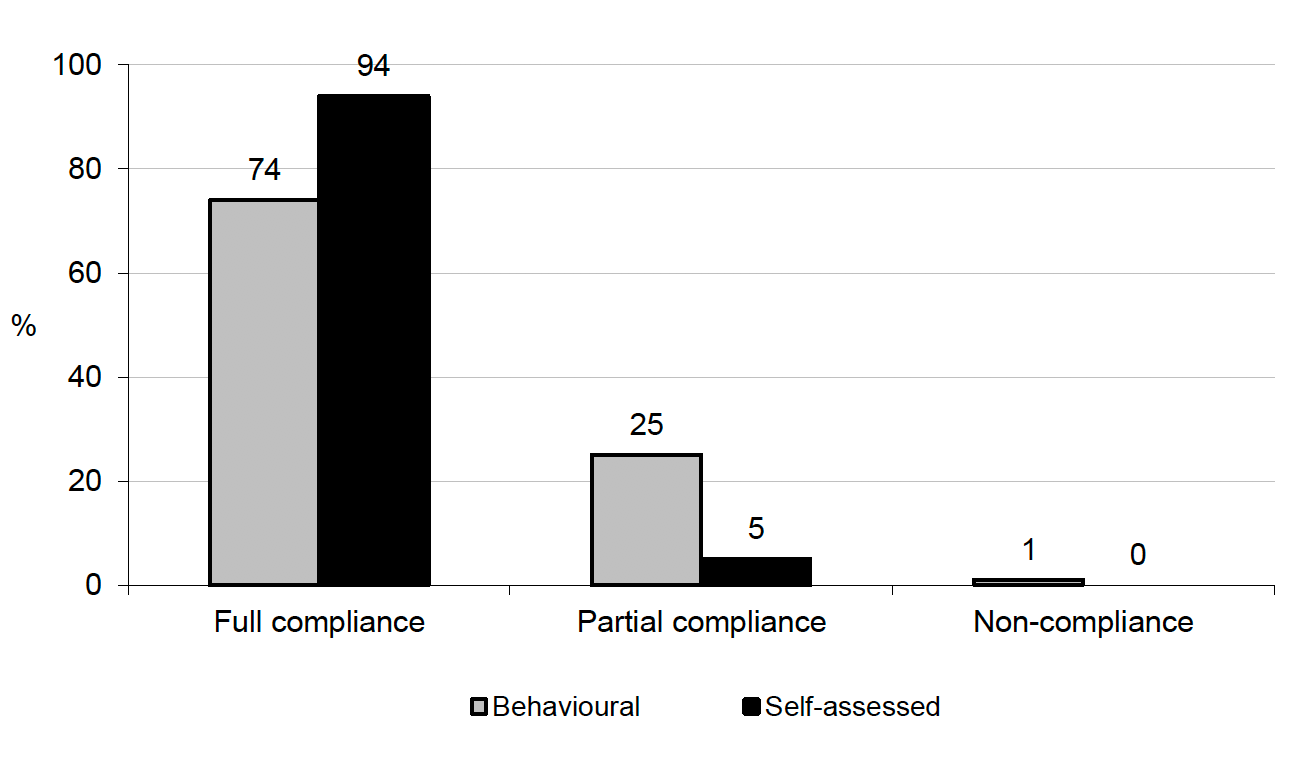
A mis-match between direct self-assessments and the behavioural measure of compliance occured when a participant was either: (i) more compliant on the behavioural measure than on their own direct self–assessment – i.e. they actually managed to comply better than they thought they did, or (ii) less compliant on the behavioural measure than their own more direct self-assessment – i.e. they complied less well than they thought they did. Table 3.4 shows that while the majority (81%) were able to make an accurate assessment of their own compliance, 18% were actually less compliant than they thought. Such assessments were similar among Index and Contact Cases.
The extent to which Index and Contact Cases were overly positive[34] about their compliance was higher at the end of the survey fieldwork period than the beginning. In wave 1, 15% of participants were classified as less compliant than their self-assessment. By wave 3, this had increased to 21%. [Figure 3.5, Table 3.4]
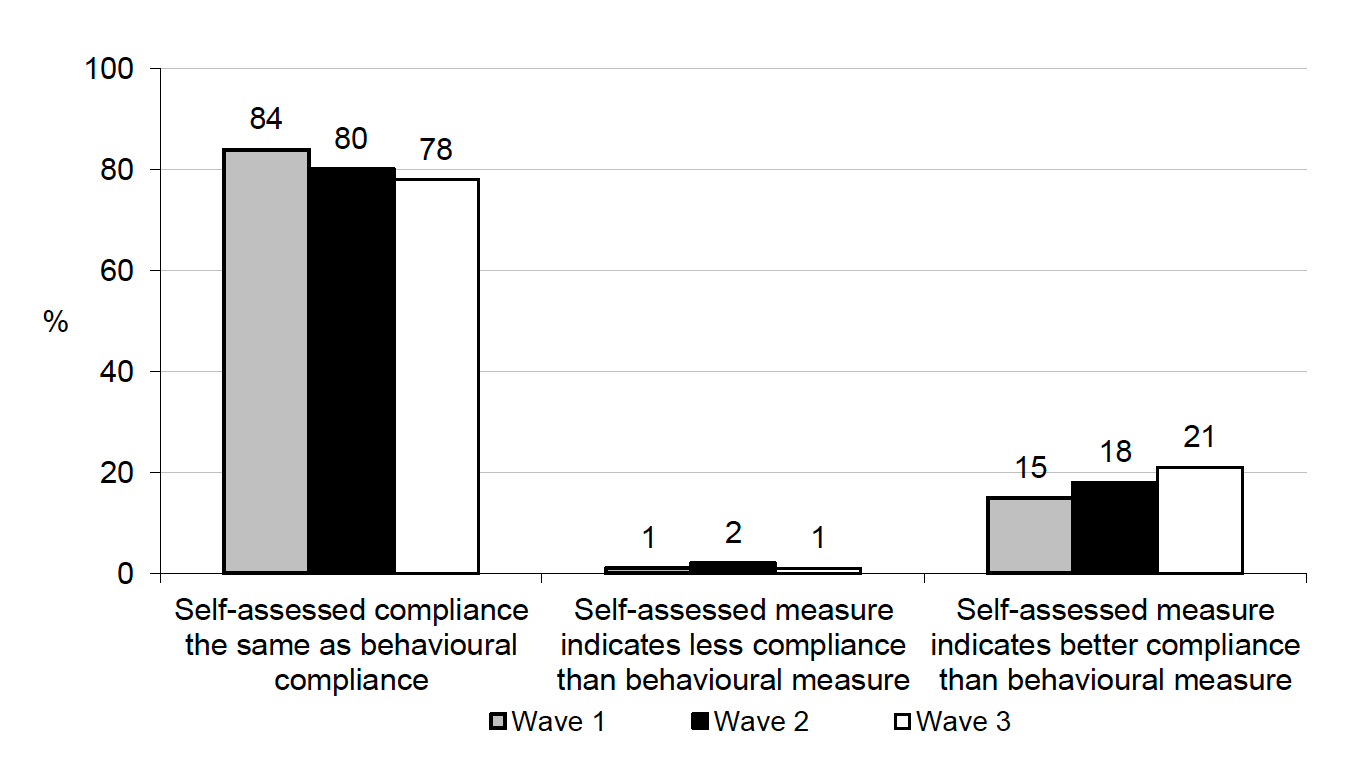
3.2.4 Compliance with specific aspects of self-isolation requirement
As outlined in the methods section (Chapter two), survey participants were asked detailed questions to measure compliance with each of the self-isolation requirements outlined below. Those in bold were used to derive the behavioural self-compliance measure discussed in this chapter:
- - Start self-isolating immediately
- - Avoid close contact with people from outside household/accommodation
- - Do not leave home/accommodation (unless COVID-19 test related reason)
- - Avoid letting non-household members into your home/accommodation[35]
- - Self-isolate for required number of days
Were some self-isolation requirements easier to adhere to than others?
Compliance with each of these requirements listed above is shown in Figure 3.6 and [Tables 3.5-3.11].
In general, and in line with earlier findings, Index and Contact Cases' adherence to the specific self-isolation requirements asked about was high. Compliance was highest on the requirement to avoid letting people into your home/accommodation during self-isolation (97%). More than nine in ten (93%) of Index and Contact Case participants reported beginning isolation either immediately or before being advised to do so. The same proportion (93%) either managed to isolate for the correct number of days or were still isolating at the time of taking part in the survey.[36]
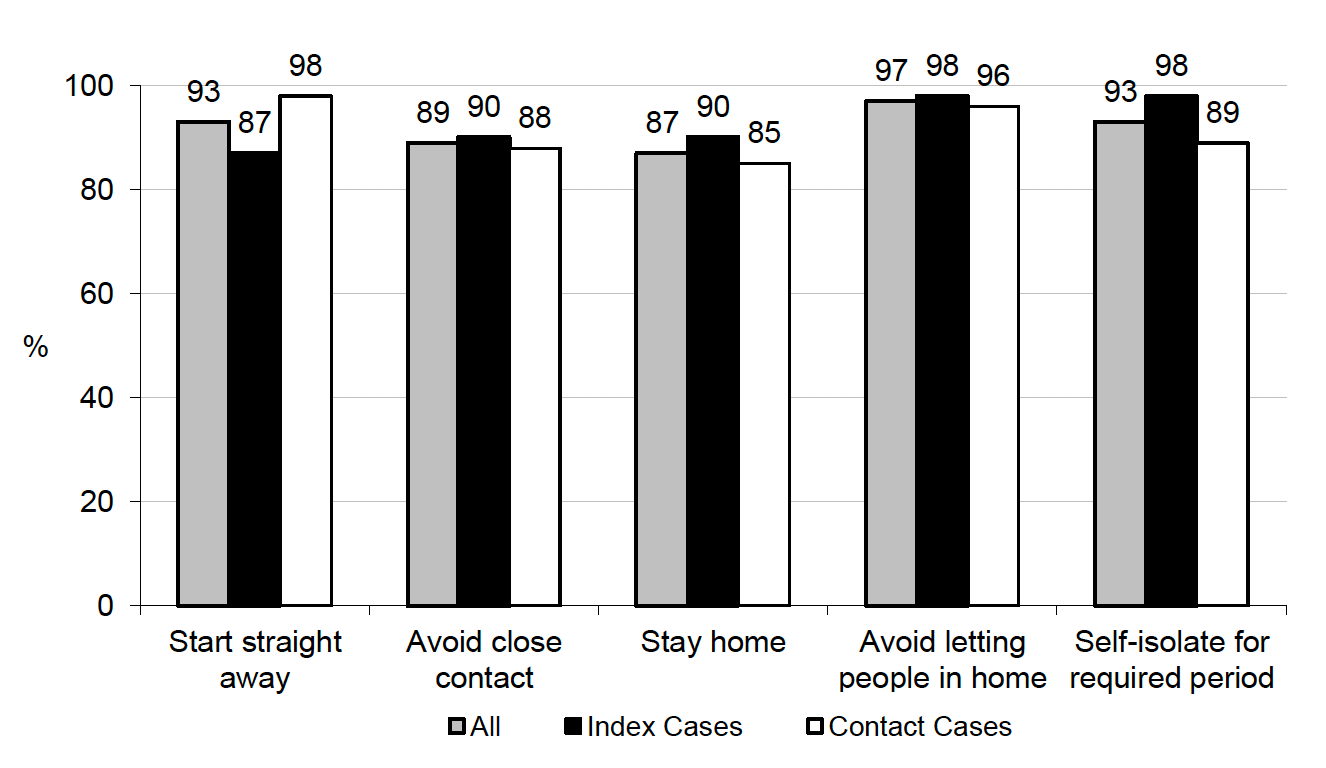
How did compliance with specific self-isolation requirements vary by case type? [Tables 3.5-3.11]
Compliance varied by case type on some, but not all, of the self-isolation requirements asked about. Most notably, Contact Case participants were significantly more likely than Index Cases to begin isolating either immediately or in advance of being advised to do so (98% and 87% respectively). The opposite was observed for the requirement to isolate for 10 days, with Index Case participants significantly more likely to isolate for the correct number of days/still be in isolation at the time of taking part (98% and 89%, respectively). Index Cases were also more likely to stay at home (or only leave for COVID-19 test related reasons).
Did adherence to individual self-isolation requirements change over time? [Tables 3.5-3.11]
Compliance with the requirement to isolate for 10 days declined across the fieldwork period (96% fully complied in wave 1, 93% in wave 2 and 90% in wave 3). A smaller, but also significant, decline was also observed on compliance with the requirement to remain at home during self-isolation (90% in wave 1 and 86% in waves 2 and 3) and with the requirement to avoid close contact with people from outside the household (92% in wave 1 and 88% in waves 2 and 3).
3.2.5 Understanding non-compliance with the requirement to self-isolate
Survey participants who explicitly stated that they did not manage to self-isolate at all were presented with a list of possible reasons for not doing so and asked to indicate which, if any, applied to them. The majority of those that did not manage to self-isolate at all were Contact Cases. The main reasons given for not managing to isolate were: testing negative (55%); not developing any symptoms (43%); an 'other reason' (36%) and having been vaccinated (10%). [Table 3.12]
Activities carried out before beginning to self-isolate
All survey participants, including those who reported starting self-isolation immediately, were provided with a list of activities and asked to identify which, if any, they carried out before they began self-isolating. Most (58%) participants did not do any of the activities listed in the period between being advised to self-isolate and commencing their isolation. The most common activity mentioned was the permitted activity of getting or returning a COVID-19 test (27%). Other activities mentioned were: going to the shops for groceries, toiletries or medicine (7%); going for outdoor recreation or exercise (e.g. run, a walk, walk a dog, sit in the park) (6%) and going to work, school or university (6%). With the exception of outdoor recreation, for which no difference was observed, Index Case participants were more likely than Contacts to report carrying out these activities prior to starting their self-isolation. [Table 3.13]
Activities carried out during self-isolation
Survey participants reporting that they left their home/accommodation during self-isolation were presented with a list of activities and asked which, if any, they carried out when they left. The most common activity reported by participants was leaving home for the permitted reason of getting or returning a COVID-19 test (68%). Other commonly mentioned activities participants left self-isolation for were: outdoor recreation (20%); going to shops for groceries, toiletries or medicine (9%) or for a medical reason (e.g. a doctor/hospital/dental appointment) (7%).[37] Among those that reported leaving home/accommodation during self-isolation, Contact Case participants were more likely than Index Cases to cite leaving for a COVID-19 test related reason (71% versus 63%) and for outdoor recreation (22% and 17%), while the opposite was true for shopping for groceries, toiletries or medicine (14% verus 7%) and for leaving for a medical reason (14% versus 3%). [Table 3.14]
Very few direct examples of non-compliance with self-isolation measures were given by the qualitative participants. Of those who reported examples, they were not always clear themselves that they had actually breached the guidelines, and argued that, if they had, they were very minor infractions.
Where they had examples, they related to leaving home during self-isolation and/or coming into close contact with others. Interviewees did also question whether going out to get a COVID-19 test or to post a COVID-19 test was allowed or not while self-isolating.
"We're going to ask you to self-isolate but by the way you can go out and post these results. That to me doesn't seem like self-isolation but anyway that was the only issue we had with it I would have said looking at it, one contradicts the other." (International Traveller)
The main issue of contention related to dog walking. Although solutions could be found for this, for example, by asking family members, friends or official dog walkers to walk the pet, participants were not convinced this was any more safe given that the dog had to be handed over, along with the lead and other items, to the walker. As a result, there were participants who took the decision to continue walking their dogs, usually at times of the day when they thought the chances of having contact with anyone else were minimal. In one case, the interviewee alerted neighbours to the situation and warned them not to approach during walks, and also took other precautionary measures.
"I did make a conscious decision that I would go out of the house every day because we've got a 10 year old Lab…I took the decision I would go out at 6 o'clock in the morning every day. Literally out the back of the house, we go up into the woods and I knew I wouldn't see another soul and so was confident that I wouldn't be in anyway spreading anything that we potentially had and so I went out every morning for about 20 minutes to take the dog out for a quick walk. Never met a soul the whole time." (Contact Case)
Two instances of driving others during the self-isolation period were also reported. In one case, the participant took a flatmate in the car for a COVID-19 test, and argued that there was no-one else who could have helped at this point. In the other case, the participant took her daughter to work on two occasions as her shift started very early in the morning, and she was concerned for her safety. It is also worth noting that an interviewee also said that he had gone outside of the house once to pick something up from the car that was parked directly outside, but did consider this to be a breach of the guidelines. Other examples of possible minor breaches raised were: an individual went outside to put the bin out; a smoker left the house briefly to smoke outside, though there was no contact with anyone else. Finally, there was an instance of a participant sharing a shopping delivery with a neighbour.
"I can stand in my garden and speak with them, over the fence to people. I tell them to keep their distance and still speak to them, so I haven't been truly 100 per cent isolated that way…that's the one thing that I - where the rules have been slightly - had to be a bit flexible because I have a neighbour…and I get her messages delivered to me. Then I divide them up and give her them and she gives us the money, so we've had to do that, like, because she couldn't shop for herself…bending the rules a wee bit. She was self-isolating as well." (Index Case)
"The only time I had to go out, it was just to go in the car and take my daughter to work and come back. That was it…That was just twice…No, she could have walked but I mean she starts at 7 in the morning so no...That was a necessity. I wouldn't let my daughter walk anywhere in (name of place) herself." (Contact Case)
When deciding to undertake non-compliant activities, qualitative participants are making decisions based on their assessment of risk and risk mitigation:
"There is a big field, we don't see anybody, so it didn't really occur to us until the Test and Protect woman phoned and said, 'You cannot take the dog out,' and then we didn't." (Index Case)
Days participants left the home:
Survey participants that reported leaving home during self-isolation were asked on which days of self-isolation they left. Those who left home during self-isolation, were more likely to do so earlier in their self-isolation period than towards the end of it. A quarter (27%) of those that left home did so within 24 hours of starting self-isolation, 21% left on day seven and 14% left on day ten. [Table 3.9]
Close contact with others from outside household:
While 89% Index and Contact Case participants did not have any close contact with non-household members while self-isolating, 5% reported having close contact with one person from outside their household during this period, slightly smaller proportions came into close contact with two people (3%) or three or more people (3%). The proportion reporting contact with those outside the household was consistent across fieldwork waves. [Table 3.10]
Number of people let into house:
While one in ten Index and Contact Case participants reported having close contact with someone from outside their household during self-isolation, the proportion reporting that close contact with non-household members took place inside their own home during this period was smaller (3%). Two percent reported that a non-household member was inside their home once while self-isolating (3% for Contact Case participants and 1% for Index Cases. [Table 3.11]
3.3 International Traveller findings
3.3.1 Perceived compliance with self-isolation requirements
Self-assessed compliance with the requirement to self-isolate was high among International Traveller participants. Nine in ten (91%) were of the view that they managed to comply with self-isolation 'all of time,' just 9% felt they responded 'some of the time' and no-one described themselves as non-compliant. As discussed earlier, such positive assessments are likely, in part, explained by the opt-in nature of the sample and social desirability among those that did take part.
Those International Travellers in managed quarantine were significantly more likely than those self-isolating at home to positively assess their own compliance (96% reported managing to follow the guidance all of the time, compared with 90% of those isolating at home). [Table 3.15]
The International Travellers interviewed as part of the qualitative research isolated both at home and in hotels with all of them stating that they complied fully with the self-isolation guidelines, and no possible breaches were reported. However, the compliance behaviour measure indicated that some of these participants were partially compliant, not fully compliant.
3.3.2 Behavioural compliance with self-isolation
In addition to the above direct assessments of adherence, how well International Travellers complied with self-isolation was also captured via the survey's behavioural measure of compliance.[38]
Based on this summary measure of behavioural compliance, seven in ten (70%) International Traveller participants fully complied with self-isolation at the point of taking part in the survey. Three in ten (29%) adhered to the requirements partially and just 1% were not compliant at all. The apparent decline in full compliance among International Traveller participants over the fieldwork period was not statistically significant. [Table 3.16]
International Travellers in managed isolation were significantly more likely than those isolating at home to fully comply with self-isolation (79% compared with 72%) according to their responses to questions on: how soon they started isolating, days isolated for and whether they left accomodation during the isolation period. [Table 3.16]
Among International Travellers, behavioural full compliance did not vary by sex but did vary significantly by age, with the youngest age group significantly less likely than others to have fully adhered to the requirements asked about (64% of 16-24 year olds fully complied, compared with 71%-72% of those in other age groups). [Table 3.16]
Those with no previous experience of self-isolating appeared slightly more likely than those that had isolated before to fully comply with self-isolation, however isolation history was also independently associated with type of isolation undergone - with those with no previous experience of self-isolating more likely than those with previous experience to be in managed quarantine - so the nature of the association is likely to be complex. [Table 3.17]
As observed for Index and Contact Cases, there was a significant association between behavioural compliance with self-isolation and views on the effectiveness of the strategy against the spread of COVID-19. International Travellers agreeing that self-isolation is effective were significantly more likely than those disagreeing to fully comply with their own self-isolation (78% and 68%, respectively). Similarly, those that agreed with the statement 'international travel restrictions will help reduce the spread of COVID-19 and new variants of it' were significantly more likely than those that disagreed to fully adhere with their own self-isolation (76% compared with 69%). [Figure 3.7[39], Table 3.17]
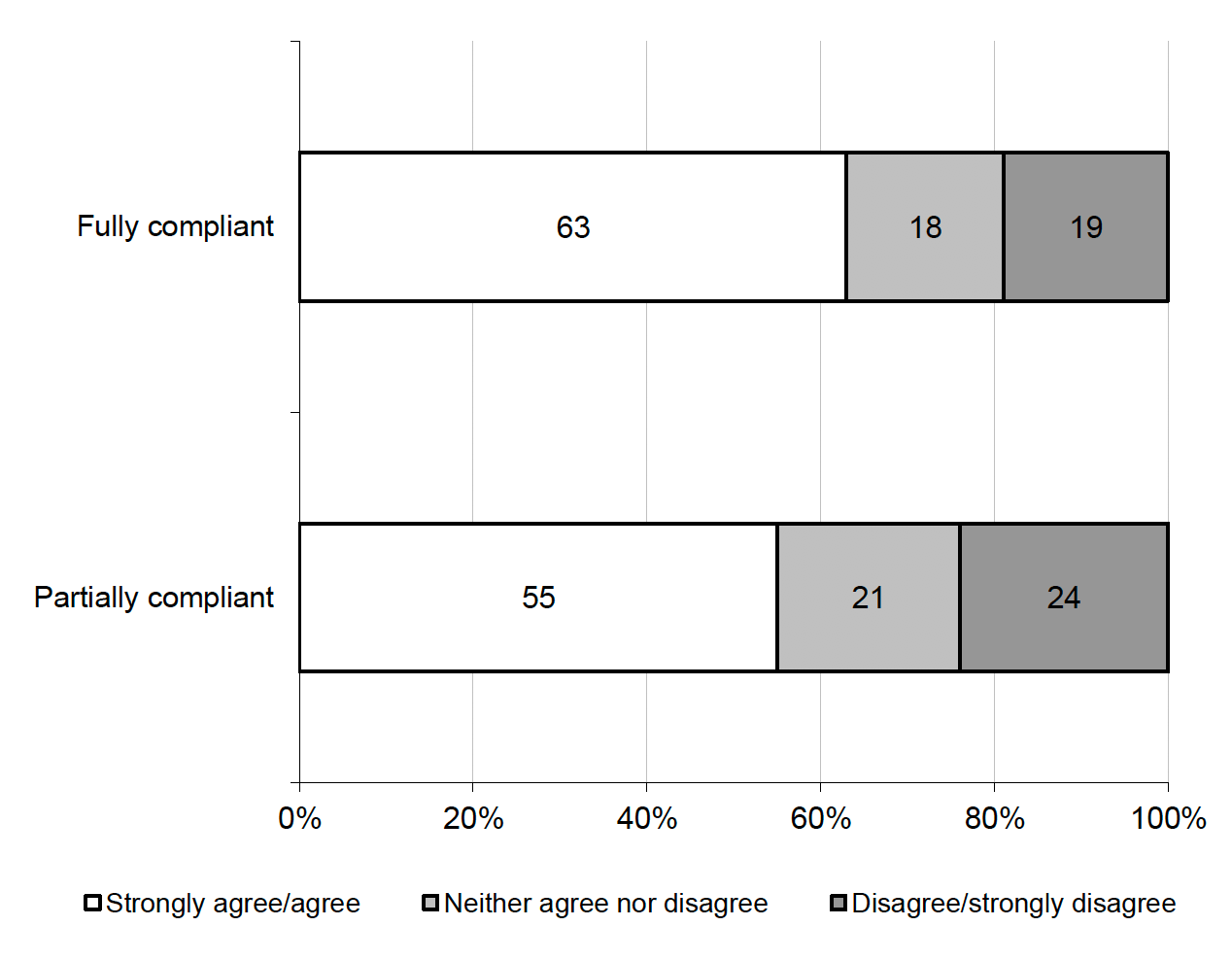
3.3.3 Comparison of self-assessed compliance and observed compliance
As was the case for Index and Contact Cases, there was a large mis-match between International Travellers' direct self-assessments of how well they managed to self-isolate and the survey's more indirect behavioural observation of how well they complied. [Figure 3.8] So while nine in ten (91%) felt they complied with self-isolation all of the time, seven in ten actually appeared to do so. [Tables 3.15 and 3.16]
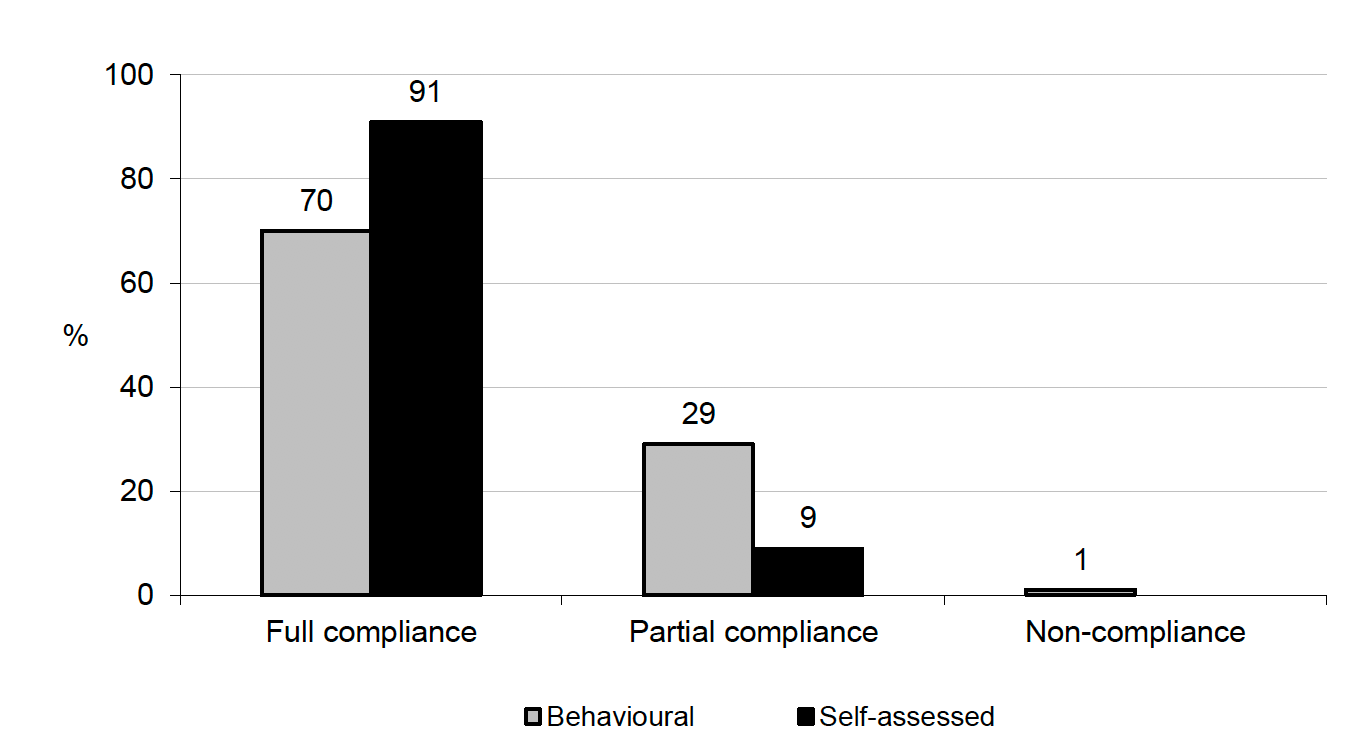
The scale and direction of mis-match between International Travellers' direct and behavioural measures of compliance were similar to that observed for Index and Contact Cases. While most clearly had a good grasp of how well they managed, according to the the behavioural measure, a sizeable proportion (19%) appear not to have complied as well as they thought they did (17% did not comply as well as they thought, while 2% were more compliant than they thought). Unlike Index and Contact Cases, there was no notable difference, over time, in the accuracy of International Traveller participants' assessment of how well they complied. [Table 3.18]
3.3.4 Compliance with specific aspects of self-isolation requirements
Like Index and Contact Cases, the specific requirements that International Traveller participants were most likely to comply with were the requirement to start isolating straight away (90% complied) and to isolate for the correct number of days (99% either isolated straight away or were still in isolation at the time of taking part). [Figure 3.9, Tables 3.19-3.25]
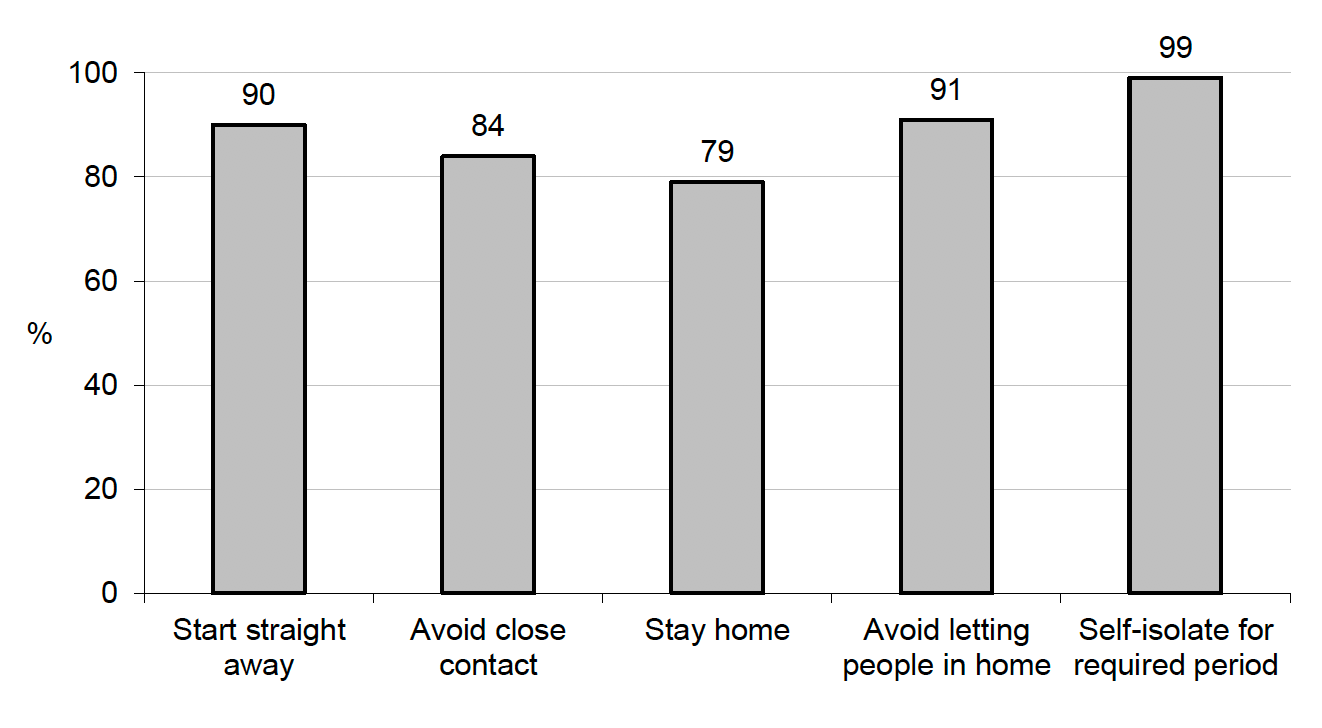
Over the survey fieldwork period there was, a small, but significant, decline in International Traveller compliance with the requirement to start isolating straight away (79% in wave 1 compared with 71% in wave 3) and the requirement to isolate for 10 days (in wave 1 96% either isolated straight away or were still isolating, the equivalent figure in wave 3 was 90%). [Tables 3.19-3.25]
The type of self-isolation undergone was significantly associated with two of the five self-isolation requirements asked about in the survey. Those in managed quarantine were significantly more likely than those isolating at home to comply with the requirement not to leave home/accommodation during isolation (87% compared with 77%) and the requirement to avoid close contact with people from outside your household (93% and 82%, respectively). [Tables 3.19-3.25]
3.3.5 Understanding non-compliance with self-isolation
In qualitative interviews several interviewees spoke about the challenges faced while complying with self-isolation. In one case, a participant contrasted a period of self-isolation abroad unfavourably with self-isolation at home in Scotland. International travellers, particularly those with experience of facing hotel quarantine within and outwith the UK, tended to have more negative views of self-isolation. They raised quite distinct issues in relation to barriers to self-isolation. Complaints were made that hotel windows did not open and air-conditioning did not allow air to circulate in the same way. Hotels were seen as being potentially more difficult places to self-isolate in as a result of smaller rooms, less personal control over the environment, including an ability to exercise, and difficulty of organising and carrying out PCR testing. There was a view that hotels were therefore more liable to create feelings of boredom among those self-isolating. One participant who came back into the UK via Heathrow stated that the information provided was of poor quality on governmental websites, and it was far from clear where and how people should self-isolate if travelling on to Scotland.
Activities carried out before beginning self-isolation [Table 3.26]
The majority (78%) of International Travellers that completed the survey did not carry out any of the listed activites asked about before starting self-isolation. The most commonly cited activities were for the permitted reason of getting or returning a COVID-19 test (8%); for an 'Other' reason (7%) and going to the shops to get groceries, toiletries or medicine (8%). Those self-isolating at home were more likely than those in managed quarantine to cite carrying out these activities before starting their self-isolation.
Activities carried out during self-isolation [Table 3.27]
The activity most commonly cited by those that reported leaving their home/accommodation while self-isolating was the permitted reason of getting or returning a COVID-19 test (74%). As was the case among Index and Contact Case participants, other common activities carried out were: going to the shops for groceries, toiletries or medicine (23%); for outdoor recreation (17%) or for a medical reason (5%). Those in managed quarantine were more likely than those self-isolating at home to cite leaving home/accomodation during self-isolation for outdoor recreation (33% compared with 16%) or a medical reason (10% compared with 4%). The reverse was true for COVID-19 test related activity and going to the shops for groceries, toiletries or medicine.
The days during self-isolation on which participants left home/accommodation:
The most common day for those International Traveller participants reporting leaving home/accommodation during their self-isolation period to leave was on day 2 (46%). Three in ten (29%) reported leaving on day 5 and 5-6% left on days 9 or 10. It should be noted that the vast majority of International Traveller participants who indicated that they left at all during their self-isolation period were those who were self-isolating at home. [Table 3.22]
Close contact with others from outside household:
While 84% of International Traveller participants reported having no close contact with others from outside their household during their self-isolation period), 8% reported coming into close contact with one person, 4% came into contact with two people and a further 4% with three or more people.
The proportion of International Travellers in close contact with someone outside their home/accommodation was higher among those who were self-isolating at home (18%) than those in managed isolation (7%). [Table 3.23]
Number of people let into house/accommodation:
Around one in ten (9%) International Traveller participants reported having at least one person from outside their household in their home or accommodation during self-isolation (9%). International Traveller participants self-isolating at home were more likely than those in managed isolation to report any visits from people outside their household during self-isolation (10% and 2% respectively). [Table 3.24]
4. Knowledge of rules and guidance
4.1 Background
The nature of the pandemic has required a responsive and evolving approach to interrupting the transmission of COVID-19 and saving lives. Guidelines, restrictions and approaches have changed over time to respond to a variety of factors such as changes in case levels (at a population and local level), the emergence of new variants, developments in scientific understanding and the rollout of Scotland's mass vaccination programme. While the Scottish Government aims to communicate any such changes as clearly as possible, there remains scope for such change to cause confusion around guidelines and requirements, particularly where nuanced differences are present within the approaches of the four nations of the UK.
Therefore, it was important that this study explored understanding of several key aspects of the self-isolation requirement such as how long to isolate for and the activities that are/are not advised during this period, as well as an evaluation of how well knowledge and compliance levels interact. This provides insight into where further clarity may be helpful to support those asked to self-isolate.
4.2 Results
4.2.1 Knowledge around self-isolation among Index and Contact Cases and requirements around own self-isolation
In the qualitative interviews, participants were asked about the main reason they had been advised to self-isolate. With a few exceptions, understanding of why individuals needed to self-isolate appeared to be good, and indeed many were already aware they would have to isolate in advance of being contacted by Test and Protect.
As expected, the majority of interviewees reported that they had isolated for 10 days in total. However, two participants stated they isolated for 12 days, for example, as a result of waiting for the results of the second COVID-19 test. Four interviewees also said they self-isolated for over 20 days, with the longest time period cited being 28 days. The reasons for this were that members of the household were contracting COVID-19 at different times during the self-isolation period, and one individual still tested positive after the first period of isolation ended and was asked to self-isolate again.
"Yes, first of all, it was my grandson, he had it, so we all had to take a test and, obviously, self-isolate, which we done. Mine's come back negative. We all came back negative actually, and then we were told tae take another one, I think it was five days, six days later. We all took it, then my daughter, she ended up with it. So that put me back again because then I had to dae more self-isolating. Then my granddaughter took it. So, I was the longest to self-isolate out of the whole house because they were saying because I hadn't taken it, I had to do it extra days. That was quite hard." (Index Case)
Survey participants were asked how long someone must self-isolate for after testing positive for COVID-19. At 88%, knowledge of the requirement to self-isolate for 10 days after a positive test was high. While 9% thought a person was required to isolate for more than 10 days in such circumstances (most in this group thought it was 14 days), 3% incorrectly thought the requirement was under 10 days. [Table 4.1] Knowledge of the requirement was higher among Index Cases (93% correct) than Contact Cases (84% correct). [Table 4.1]
Women were more likely than men to correctly state the 10 day self-isolation requirement for positive cases (90% and 85% respectively), as were those aged 45-64 (90%) compared with other age groups (79-80%). Variations were also evident by income (93% among those with a household income of £52,201 or more compared with 83% of those with an income of <=£16,900). Those whose last COVID-19 test was positive (93%) were more likely to correctly state the requirement here compared with those whose last test was negative (84%). [Figure 4.1, Table 4.1]
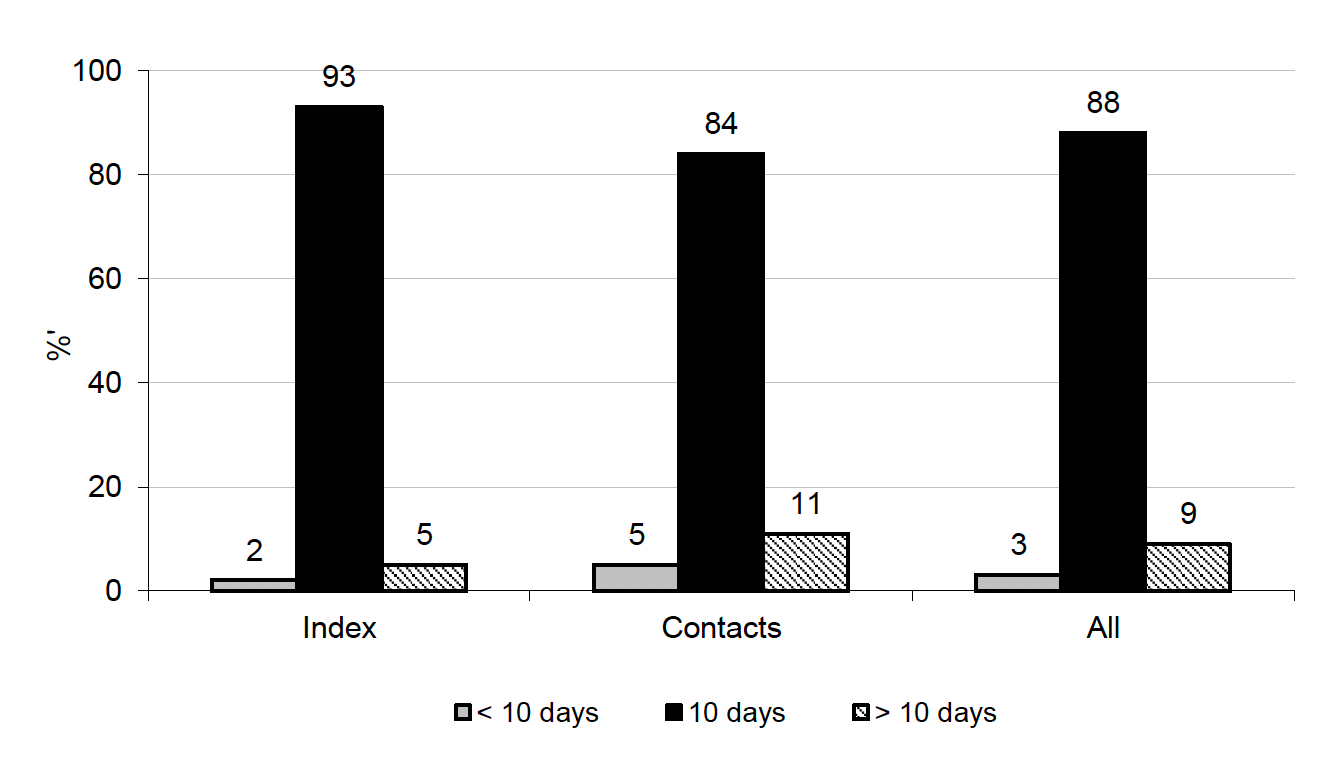
Knowledge of a close contact's requirement to self-isolate for 10 days, even if they later test negative themselves was also high among survey participants. Nine in ten (91%) were aware of the requirement, 5% thought 10 days was incorrect and 3% were not sure either way, with no significant variations by case type. Those with the highest reported household income were more likely than those on the lowest to be aware of the requirement (96% of those on £52,201 or more, compared with 92% with a household income of <=£16,900), as were those who agreed that self-isolation was an effective strategy against the spread of COVID-19 (92%, compared with those who disagreed (79%). [Table 4.2]
While qualitative interviewees were relatively clear on the amount of time they needed to self-isolate for, there was some confusion among participants more generally about what the overall COVID-19 restrictions meant at different times.
"We keep giving mixed messages. Even things like the hands, face, space and the FACTS, you're seeing both of these two things all over the place. You don't know – lots of people don't know what it is and it just seems we're getting very mixed messages all the time." (International Traveller)
"I think over the summer it was a bit confusing because they seemed to change like every week. The tier system was like confusing, what was opening week by week and like comparing it to different areas. But the national approach, well I suppose lockdown is pretty simple, yeah I struggled in the summer to see what was allowed and what's not." (Index Case)
On the whole, participants recognised that the COVID-19restrictions imposed by the UK Government were different than those imposed by the Scottish Government, with widespread consensus that the pace of relaxing restrictions has been slower in Scotland. There was, however, confusion among many qualitative participants about which rules applied where, especially since participants reported consuming media content from across the UK (see Chapter 5 'Attitudes' for more on thoughts related to the different approaches of the four nations within the UK).
"They are quite similar in places, but they are also different in places. Sometimes the most confusing is this different timeline, so in England you've got different rules, sometimes it's just a week's difference, sometimes it's a bit longer. But for example, now you've got pubs open in England, or the restaurants, or the places outside open in England but they are still not open in Scotland. So sometimes when you listen or read the news and you don't catch carefully about Scotland or England that maybe confusing." (Household Contact Case)
While there were interview participants who thought the information provided by Test and Protect was clear and they knew what was expected of them, others felt that it was confusing or contradictory, and they were left uncertain of what activities were permitted during isolation. Some participants were also critical of the quality of advice they received, feeling that they were not given enough advice about how to self-isolate within households with other occupants who did not have to isolate or were not informed what advice was on offer. For example, participants reported feeling uncertain about:
- Length of isolation: and the circumstances that may lengthen / shorten self isolation (e.g. Whether they were required to self-isolate further if household members became infected during the isolation period)
- Testing: When and how often they should be tested for COVID-19
- Testing: Whether they were allowed to post their COVID-19 test during isolation (particularly if they had tested positive for COVID-19)
- Process: What to do if a child tests positive for COVID-19
- Process: When to contact the NHS regarding COVID-19 symptoms
- Permitted tasks during isolation: Whether support bubbles applied during isolation
- Permitted tasks during isolation: and whether this varies if you have a positive or negative COVID-19 test (e.g. whether they were able to drive household members somewhere whilst wearing a mask)
- International travellers: whether they can self-isolate at home or require hotel quarantine (and who to contact if they have questions).
Participants thought clear information and guidance addressing these issues should be developed and communicated to those asked to self-isolate. Participants stated that they would have found it helpful if, after the initial call, Test and Protect contacted them in writing to summarise the most salient points and provided details of who to contact if they had any questions.
4.2.3 Relationship between knowledge of self-isolation and self-isolation behaviour
Three-quarters (74%) of Index and Contact Case participants who correctly identified that a positive case should self-isolate for 10 days were fully compliant[40] with their own requirement to self-isolate.[41] This was significantly higher than the proportion of those unaware of the requirement that managed to fully comply with their own self-isolation (68%). [Figure 4.2, Table 4.3]
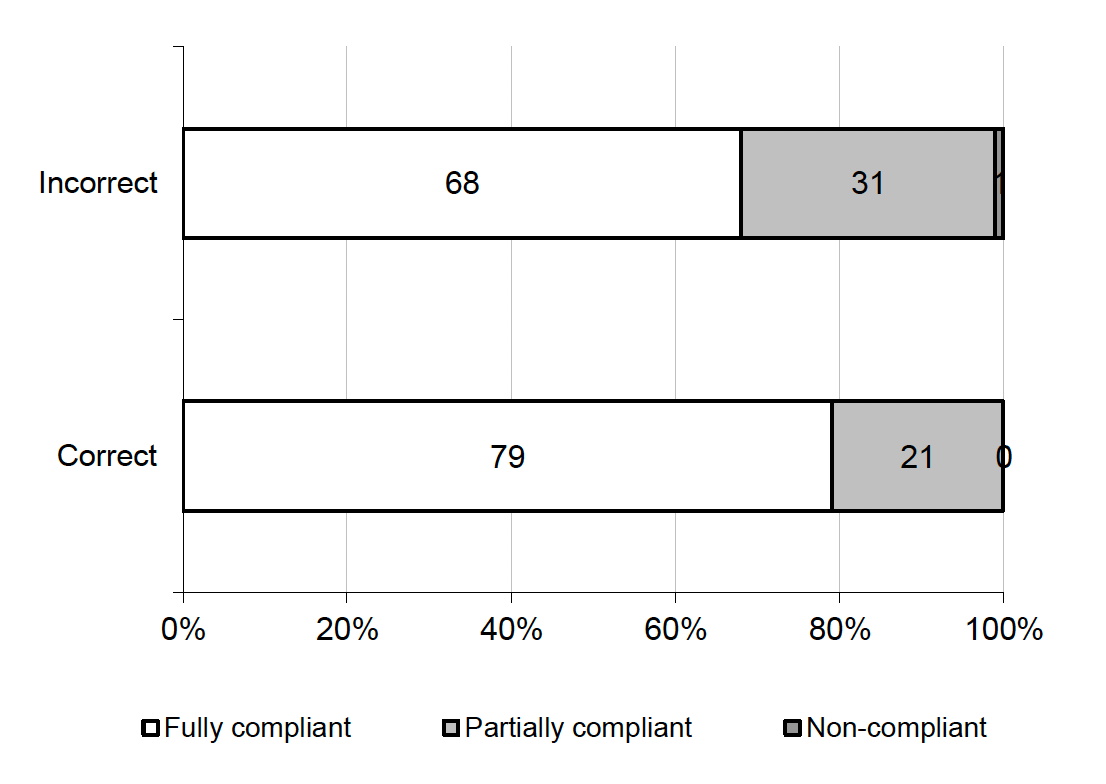
Participants were presented with a series of activities and asked whether they believed each was allowed or not during self-isolation[42]. On the whole, understanding of what was and was not permitted during the self-isolation period was high among Index and Contact Case participants. The majority (80%) were aware that COVID-19 test related activities are allowed, while there was almost universal recognition that activities such as meeting people from outside your household or going to shops for any reason are not permitted. [Table 4.4]
There was some ambiguity about whether leaving self-isolation for a medical reason was allowed or not with 18% incorrectly concluding that it was permitted and a similar proportion (16%) reporting being uncertain.[43] One in ten participants were unsure whether it is ok to leave self-isolation to care for a vulnerable person (9%), similar to the proportion who were unsure whether leaving to get or send a COVID-19 test was allowed (9%). [Table 4.4]
Men were significantly more likely than woman to think that the following activities were permissable while self-isolating: attend a planned medical appointment (24% versus 16%) and helping a vulnerable person (6% versus 3%). Compared with older age groups, those aged 16-24 were more likely to think attending a planned medical appointment was allowed (27%, compared with 17% among those aged 25 and over) and that outdoor recreation was permissable (11% compared with 5%). [Table 4.5]
For several activities there was a clear significant association between knowledge of whether an activity was allowed or not and whether a person carried out the activity themselves or not.[44] For example, those incorrect or unsure about whether it was permissible to leave self-isolation for a medical reason were 4 times more likely to leave home for this reason than those who were aware that it was not allowed (12% compared with 3%). [Figure 4.3, Figure 4.4, Table 4.6]
| Activities | % who knew activity not allowed but undertook activity | % who thought activity was allowed/were not sure but undertook it |
|---|---|---|
| Outdoor recreation | 13 | 49 |
| Medical reason (e.g. doctor/hospital/dental appointment) | 3 | 12 |
| Take children to/from school | 1 | 8 |
| Provide help for vulnerable person | 0 | 3 |
| Activities | % who knew activity was allowed and undertook it | % who thought activity was not allowed/were not sure but undertook it |
|---|---|---|
| Get/return COVID-19 test | 34 | 73 |
4.3 Knowledge around self-isolation among International Travellers
4.3.1 Knowledge of the purpose and requirements around own self-isolation
International Traveller survey participants were asked the extent to which they agreed that it was easy to understand the Scottish Government information on international travel rules during the pandemic. While around half (53%) either agreed strongly or agreed that this it was easy to understand the information, 32% disagreed. Those self-isolating at home were more likely than those in managed isolation to agree that the information was easy to understand (55% and 46%, respectively). [Figure 4.5, Table 4.7]
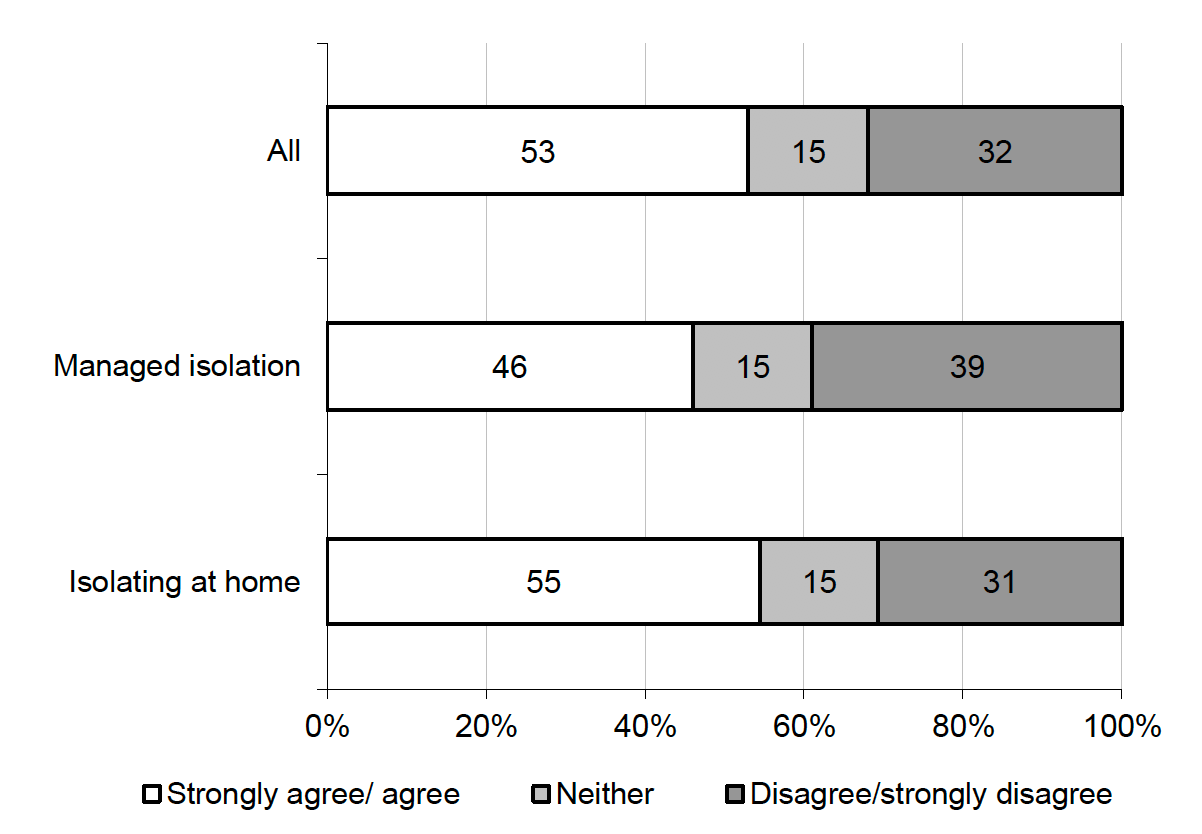
The qualitative interviews also demonstrated that there was some confusion about the requirements of self-isolation among the International Traveller group. This mostly related to when and where self-isolation should take place if they first arrived back in the UK outside of Scotland.
"Earlier this year we decided that we were going to come back [to Scotland] when we could, because there was no indication as to how the hell we were going to get back. And the big problem was that nobody could advise us. We were in [name of place], our British representative…our consul, was unable to give us any information. We were referred then, if you tried to phone through you then had an answerphone, 'Please refer to the website,' and the website of course was out of date. Then we came through to the Scottish Government and I'm still waiting on a reply from them…I didn't know when I got into Heathrow whether I was certainly going to be able to go through and ultimately into Scotland. I couldn't get an answer as to what the rules and regulations were because I was travelling into Scotland via England." (International Traveller)
4.3.2 Knowledge of self-isolation requirements more broadly
International Travellers' knowledge of the number of days a positive COVID-19 case needs to self-isolate for was broadly split between those who thought it was 10 days (55%) and those who thought it was 14 days (37%). [Table 4.8] Fourteen days was the previous isolation guidance, updated in December 2020 to 10 days.
While high (80%), knowledge of a close contact's requirement to self-isolate for 10 days, even if they later test negative themselves was lower among International Travellers than among Index and Contact Cases. Since International Travellers have to isolate by virtue of having travelled as opposed to any test result, it is perhaps not unexpected that knowledge of this requirement is lower. [Table 4.9]
4.3.3 Relationship between knowledge of self-isolation and self-isolation behaviour
While there was a clear association between knowledge of self-isolation requirements and self-isolation behaviour, in terms of overall compliance, for Index and Contact Cases, this was not the case for International Travellers. Irrespective of whether or not they knew the number of days a positive COVID-19 case should isolate for, around three-quarters fully complied, and a quarter partially complied with their own self-isolation. [Table 4.10]
International Travellers' knowledge of the permissability of particular activites during self-isolation followed a similar pattern to Index and Contact Cases and, on the whole, tended to be either similar or lower. Where ambiguity did exist, it tended to be more pronounced than observed among Index and Contact Cases. For example, close to two thirds (63%) of International Travellers were either incorrect or unsure about whether or not going out for a planned medical reason was ok[45]. Around three in ten didn't know whether leaving to provide help or care for a vulnerable person was allowed or not, similar to the proportion confused about whether going out to get groceries, toiletries or medicine (29%) or to get or send a COVID-19 test (27% incorrect or unsure) was permissable or not. [Figure 4.6, Figure 4.7, Table 4.11]
| Activities | % who knew activity not allowed but undertook activity | % who thought activity was allowed/were not sure but undertook it |
|---|---|---|
| Outdoor recreation | 9 | 44 |
| Medical reason (e.g. doctor/hospital/dental appointment) | 2 | 6 |
| Take children to/from school | 1 | 7 |
| Provide help for vulnerable person | 1 | 4 |
| Activities | % who knew activity was allowed and undertook it | % who thought activity was not allowed/were not sure but undertook it |
|---|---|---|
| Get/return COVID-19 test | 47 | 77 |
For International Travellers, the association between knowledge of permitted activities and whether a participant themselves reported carrying out the activity during self-isolation was similar to that observed for Index and Contact Cases. Those with a better awareness of the permissability of an activity during self-isolation were less likely than others to carry out disallowed activities during their own self-isolation. For example, 9% of those who knew outdoor recreation was not permitted reported leaving isolation themselves for this reason, whereas 44% of those incorrect or unsure about it left isolation for this reason. [Table 4.12]
Contact
Email: socialresearch@gov.scot
There is a problem
Thanks for your feedback